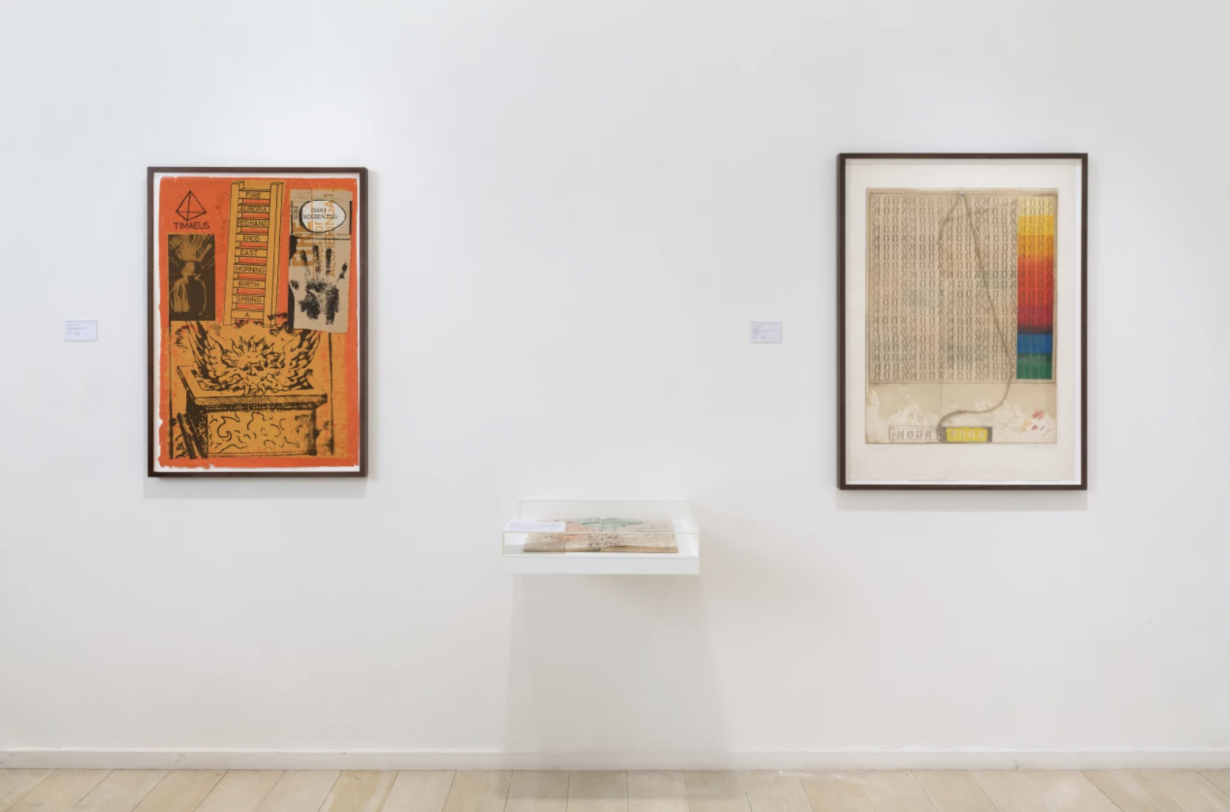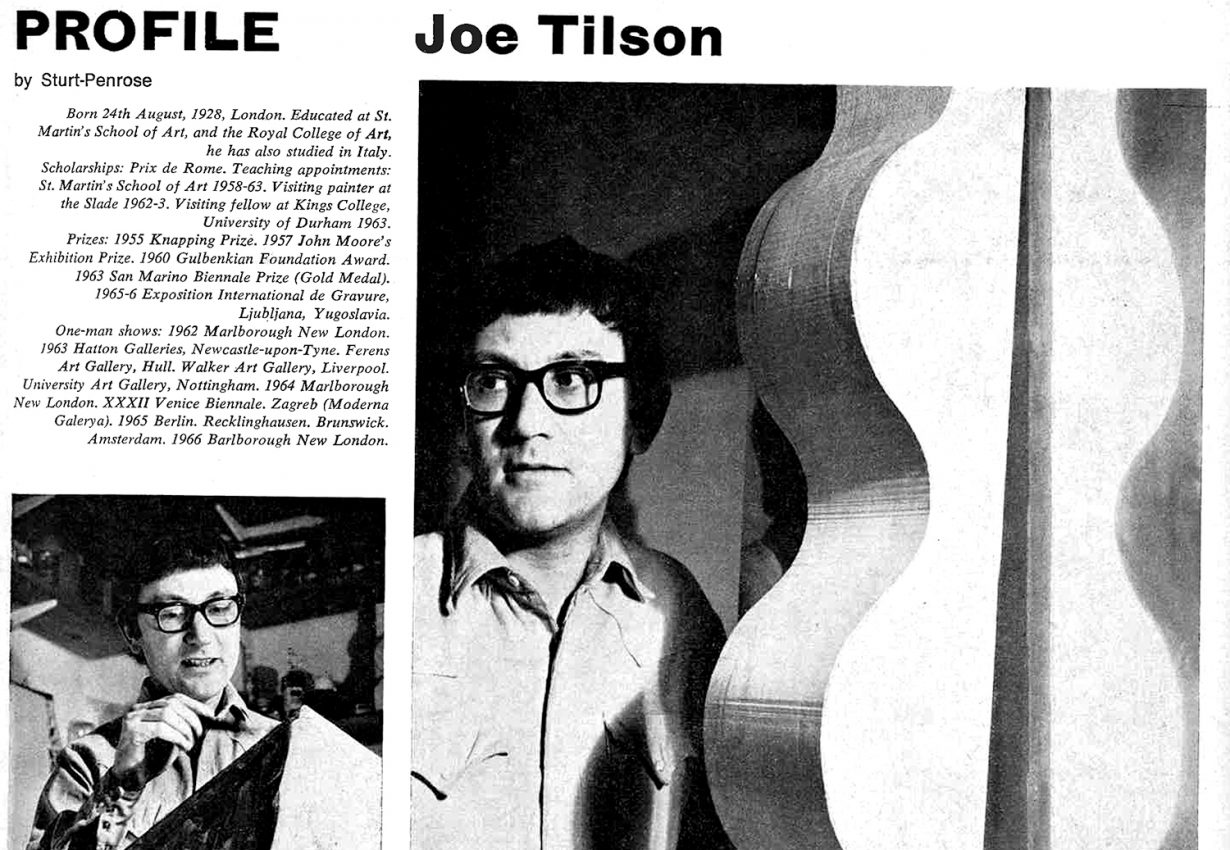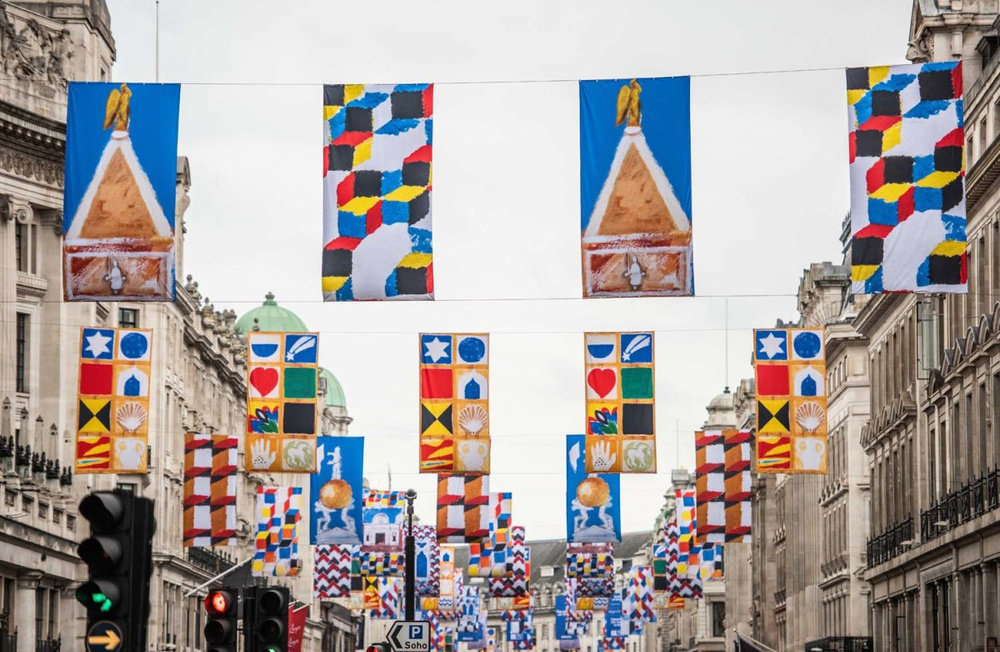‘I am interested in the transient, expendable, mass-produced dreamworld of the big stores; in television advertising, the movies, the mass media, and life in the city. I am concerned with reality and dreams – the reality that I can discover via my senses, shaped by intellect, becomes this thing I do’. In this profile from the pages of Arts Review in February 1966, the British pop artist tries to dish the dirt on Hockney’s final exams, sticks the knife into London’s art schools, debunks the idea of a ‘London’ art scene and tells interviewer Barrie Sturt Penrose what painting is really all about.

Barrie Sturt-Penrose English art has reached an extremely interesting and exciting moment in its development. Many of the painters and sculptors who have contributed to its increasing importance now live in London. Are you conscious of belonging to a vital community here in London?
Joe Tilson No, I don’t think I’m conscious of belonging to a community as such. There’s no art colony in London. I’m conscious of being in a situation where communication between, for instance, New York and London and the rest of Europe and London is very speedy. One seems to travel more than painters did twenty years ago. Thus in a situation where everything has changed I don’t really think it is accurate to say that London has taken over from Paris or New York. It’s true that Paris no longer dominates the international scene at all. London has become one of the other centres where art is possible – with New York. I think we need to be very careful not to think in terms of the past, in terms of thinking that Paris had complete control over every other country, and that London now occupies a similar position. It would be awful to swap the earlier British provincialism for a new form of British chauvinism. But there’s little doubt that there is a feeling of great potential in what has been called the New English Art.
BSP You were at St. Martin’s School of Art and at the Royal College
of Art. What has been in your opinion the significance of the professional art schools in the formation of the New English Art?
JT The Painting School of the Royal College of Art has changed from the easy-going Fifties, under Professor Rodrigo Moynihan, to a rigid dull regime under Professor Carel Weight and with one exception a list of the most nowhere artists to be found at the Royal Academy. Around 1954 Riley, Blake, Denny, Smith and myself were there. There was no teaching but great freedom to do what you wanted to and much interchange of ideas amongst the students. Allen Jones and Hockney were at College around 1960-61. Jones was expelled after his first year and Hockney was failed* in his Final written exams and was busy printing his own Diploma when the Principal gave in and passed him.
No one of interest that I can remember came from the Sculpture School when I was at the Royal College, but under the new Professor, Bernard Meadows, it is very good. The Slade teaching has a much more positive effect, though not necessarily a good one. The Sculpture Department is appallingly bad. The Slade has been more lively lately due mainly to Harold Cohen teaching there plus other Visiting Teachers such as Kitaj, Hodgkin, Auerbach and Denny. St. Martin’s Painting School is zero on anyone’s list. St. Martin’s Sculpture School is the best I have seen and so are the results, both in work and the interchange of ideas between Teacher and Students, and Teachers and Teachers, because it is this second thing that has helped most in London to develop people’s attitudes and ideas.
In London, as opposed to New York, everybody teaches. There are obvious disadvantages to this, but one great advantage is that you are forced to meet other painters and sculptors every week in a situation where serious discussion can take place. There are several examples where a serious interchange of ideas took place. Every Wednesday for two years Tony Caro, Dick Smith, Harold Cohen and myself met for lunch when we were teaching at St. Martin’s, and many other people joined us, painters, sculptors, critics, architects. I think that it is this exchange of ideas between painters and sculptors that has helped the London scene. Not the Art Schools, as such, or the older people directing and teaching in them.

BSP I want now to talk about your own work. Firstly, what gives you your basic subject matter. Are your images always urban in origin?
JT I’m very conscious of living in a city. I find it visually exciting. I think that in a city like London the rigid pattern of people’s lives tends to make them very unaware of the things around them. I mean the pattern that you get up in the morning, you go out and look at the number of a bus, you pick up information like ‘Is it raining’? In fact you aren’t really looking. For instance, I’m sure the rush-hour crowds passing up Oxford Street very rarely look-up at the big neon-sign over Studio One. I did a series of paintings and cut-outs based on ideas from neon-signs and cinema architecture. I start from life today in the city and our communications techniques and the imagery they use. I use these within the field of Fine Art – insisting on a rigorously formal solution.
I am interested in the transient, expendable, mass-produced dreamworld of the big stores; in television advertising, the movies, the mass media, and life in the city. I am concerned with reality and dreams – the reality that I can discover via my senses, shaped by intellect, becomes this thing I do. I make objects that stand on their own, with their own life and meaning. They relate obviously also to other things that have been the starting point, but I take over these things and use them to make something completely new. When I view the objects I make, there is an interpenetration of meaning from other things, a sort of two-way process in your mind involving all the senses, and an ambiguity even in the seemingly unequivocal images that I often use. If the form is precise enough a total metamorphosis takes place mainly in the spectator’s mind.
BSP Let me ask you a very basic question: What do you consider painting to be all about? After all, the very activity of painting has altered so much during the last four decades that the answer to my question is still debatable.
JT For me, painting is a private action like making love; concerned with the solution of individual problems and not concerned with direct communication except with one self. Painting is about things only half known before the event, clarified in the transformation of concept into form-concept. Paradoxically the most intense and durable communication is made by those painters and sculptors who work without necessarily thinking of the public. Recent developments in non-verbal communication such as the Television and the Cinema, have freed the painter from the many compromising activities connected earlier with painting.
First published in Arts Review, 19 February 1966

5 March, 1966
Letter to Joe Tilson
Dear Joe,
You are quoted as saying (‘Profile’, Arts Review, 19th February, 1966) that Saint Martin’s Painting Department is zero on anyone’s list. Is this a case of biting the hand that fed you? You drop a small number of distinguished names; does it not strike you as odd that among them Denny and Auerbach, as well as yourself, should have been painting students at Saint Martin’s, that Blake, Smith and Cohen should have been teaching painting there at the same time as you, and that those illuminating exchanges of yours with Caro, Cohen and Company were during that time? Perhaps something was done for the students, too? If not we share the blame. If the Sculpture Department has provided a ‘school of sculpture’ in the other sense and a rallying point for the best in avant-garde ideas, that was in response to historical need. With painting the need has been otherwise, no one school could or should bag the kitty. After all, there are five famous London Schools under the I.L.E.A., as well as The Slade, Royal College and R.A. Schools, all pretty renowned for painting. By and large Saint Martin’s painting department may have been the most tolerant and given to its staff and students an undemanding environment within which those personal exchanges between individual artists and aspirants might be easily made, which I believe in as much as you do. There are also serious educational aims which may not be so easily measured as you seem to think. To be good does a school have to be on ‘anyone’s list’? Like a night club or a new men’s boutique?
And who were these stultifying greybeards whom you speak of – the older men who gave so little – Kinley, Coker, Greaves, Fussell, de Francia? Ah no, of course you mean myself, who taught you Costume Life Drawing in the Beginners, when we were both new boys and picked over the carcass of the Italian Renaissance together. You were the brightest boy in the art appreciation class and we marked you out then as a likely for the Prix de Rome (and wrote a good recommendation later to help you get there). Yes, Joe, I knew you would go far. But you have not been back to see us lately – not since you gave up teaching here three years ago. Perhaps you ought to come and see if things are just as bad without you. It might be a risk? The only man I ever felled was standing at your mantelpiece, but then he wanted to be felled, didn’t he? Some famous men do.
Yours ever,
Freddy.
Frederick Gore, A.R.A., Head of Painting Department,
St. Martin’s School of Art, London
5 March, 1966
Letter to the editor
Sir,
Mr Joe Tilson may think it becoming in your columns to foul his own nest and to describe those who have emerged from it since he left, but I think it is right in the interests of accuracy to record that all those members of the staff of the Painting School of the Royal College of Art whom he condemns as ‘the most nowhere artists to be found at the Royal Academy’ were appointed on the advice of Mr Rodrigo Moynihan and were teaching at the RCA while he was a student. The only appointments made on the advice of his successor, Professor Carel Weight, are Mr Peter Blake, Mrs Jean Bratby, Miss Sandra Blow and Mr Hamilton Fraser.
It is quite untrue that Mr Hockney was failed in his final examination for in point of fact he is only the third person to have received the Gold Medal of the College during this century. He is at present a Visiting Lecturer in the Department of Print Making of the School of Graphic Design. Mr Allen Jones did fail to pass the first year examination, but this decision which later turned out to be mistaken, was probably right at the time and he himself has remained a close friend of the RCA, and claims to have been trained here.
Amongst the painters who have left during the last few years I might mention as an indication of continuing vitality: Patrick Caulfield, David Hockney, Ronald Kitaj, Frank Bowling, Derek Boshier, Peter Phillips, John Selway, Brian Wright, William Culbert. Many others have not yet had time to make substantial reputations for themselves and I recollect that it was a good many years before Mr Tilson himself attained success.
Yours, etc.
Sir Robin Darwin, Principal, Royal College of Art, London
19 March, 1966
Letter to the editor
Sir,
I read with interest that Sir Robin Darwin felt that I was a ‘close friend’ of the Royal College of Art. Pleasant as this would seem, those words have a reciprocal meaning which can hardly describe our relationship. His loaded phrases are not in the ‘interests of accuracy’ mentioned in his letter. Moreover, since we do not know each other, I can only conclude that he has again been misinformed.
Yours, etc.
Allen Jones